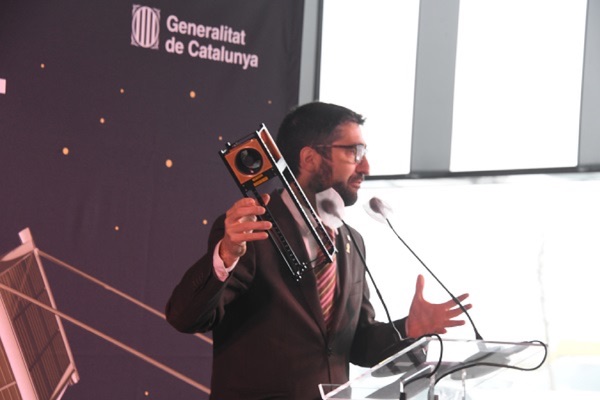Catalonia’s space ambitionsby Marçal Sanmartí
|
 Catalan surrealist artist Salvador Dalí established the “Centre of the Universe” at the Perpinyà train station in French Catalonia, after experiencing a vision of cosmogonic ecstasy there in 1963. |
In 1996, the Institute of Space Studies of Catalonia, or IEEC, was stablished as a private, non-profit foundation to foster space R&D in Catalonia. It currently has a board of trustees composed of the Catalan Government (Generalitat de Catalunya), the University of Barcelona (UB), the Autonomous University of Barcelona (UAB), the Polytechnic University of Catalonia (UPC), and the Spanish Research Council (CSIC). The IEEC also belongs to the Institució CERCA - Centres de Recerca de Catalunya, a hub of Catalan Research Centres.
| The IEEC has been the main force behind the small but flourishing space industry in Catalonia and also backed the idea of creating a tiny Catalan Space Agency in the near future. |
The IEEC (Institut d’Estudis Espacials de Catalunya) is a research institute that studies all areas of space and space sciences, including astrophysics, cosmology, planetary science, Earth observation, and space engineering. Its main objectives are to promote astronomical and space research; become an internationally recognized center in order to attract talent and foster collaborations, both locally and worldwide; be an efficient agent of knowledge, innovation, and technology transfer in its field; and carry out science awareness to society by communicating scientific culture.
The IEEC ranks well among international research centers, producing a good number of high-impact publications and leading some world-class projects in collaboration with top international institutions. The IEEC also develops instrumentation for multiple space missions thanks to a team of engineers with extensive experience in the aerospace sector and other sectors that emphasize innovation. As a private non-profit foundation, the IEEC can have a versatile relationship with private industries and companies that ultimately fabricate the qualified flight hardware.
An example of that work is a nanosatellite launched in 2018 from the Satish Dhawan Space Center in India. The nanosatellite, CubeCat-1, had seven scientific experiments on board and was created by the Polytechnic University of Catalonia but fully financed by the IEEC. Ironically, a predecessor was called CubeCat-2 and was launched from the Jiuquan space center in China two years earlier.
This institute has been the main force behind the small but flourishing space industry in Catalonia and also backed the idea of creating a tiny Catalan Space Agency in the near future. However, it is not the only backer. The chamber of commerce of Barcelona, Spain’s second largest city and capital of Catalonia, organised on February 12, 2020, its first meeting on New Space Economy. The meeting was organized with the support of not only the IEEC but also the Catalan Government, Catalan universities and private companies, the European Space Agency (ESA, and the European Commission under its Astropreneurs program; European Union’s Space Startup Accelerator. Around 250 businesspeople attended the meeting.
The same actors announced on December 18 the creation of a spaceport in Lleida, about 130 kilometers away from Barcelona. It will be used for suborbital missions, rocket testing purposes, new space business, and host an educational center for new space companies, the second in Europe after the one in Lampoldshausen, Germany. The Lleida spaceport, though, is not going to be used for horizontal launches. That means that the Catalan government’s plan to launch a tiny constellation of nanosatellites will likely not use this new spaceport but instead the spaceport in French Guiana primarily used for the European Space Agency projects.
The Catalan Government’s reasons behind its New Space strategy
When Jordi Puigneró, the digital policy minister of the Catalan autonomous government, used the term “Catalan NASA” during the presentation of the satellite launch plan, many political opponents and Spanish media mocked the project. But the idea is not launching astronauts to outer space like the Apollo missions, or doing interplanetary research like the current NASA missions to Mars. The idea is to create a commercial demand to boost the local New Space Economy. Instead, it’s a smaller version of what NASA is doing with SpaceX or Blue Origin, and what other space agencies are planning to do too. And that’s one of the main reasons behind the making of a tiny space agency: the creation of qualified jobs. At the moment, 26 companies related to the New Space economy operate in Catalonia, but the Catalan government expects that this New Space Strategy could create in the next four years 1,200 jobs and revenues of €280 million (approximately US$340 million). Jobs like these are desperately needed in Catalonia, where the unemployment rate is above 13%.
| The Catalan government expects that this New Space Strategy could create in the next four years 1,200 jobs and revenues of €280 million (approximately US$340 million). |
COVID-19 is having a huge economic impact worldwide, but the case of Spain is quite severe. The country will probably suffer the biggest economic impact inside the European Union, with a GDP decrease of 11.6% according the OECD. Catalonia is not escaping from that impact; quite the opposite. Catalonia and its world-famous capital city, Barcelona, even though being a manufacturing powerhouse in Spain, relied quite heavily on the international tourism industry: 12% of its GDP back in 2018. These tourists completely disappeared during the pandemic. Through these hardships a ray of light appeared though, in the form of European Union recovery funds. NextGenerationEU is a €750-billion temporary recovery instrument for economic reconstruction. But these investment funds are not handouts: they are linked to specific projects that can bring economic returns and modernize economies. And here is where the Catalan New Space Strategy comes in. It’s one of the Catalan government projects aimed to attract part of these EU recovery funds.
That links directly to another business strategy the Catalan government is deploying to attract those funds: its 5G Strategy for Catalonia. The Catalan government has been actively trying to make Catalonia a hotspot for 5G technologies in Europe. It has been deploying fiber optic cable all around Catalonia and it recently announced the arrival to Barcelona of an Internet submarine cable, among other initiatives. A constellation of satellites would be a very useful addition to the 5G capabilities of Catalonia. Another main reason behind the creation of a nanosatellite industry is to have a homogeneous 5G coverage for Internet of things (IoT) services all around the territory., including the rough and lightly population regions in the Pyrenees.
And that links to the third main reason behind the New Space Strategy, Earth observation and climate change. More than 60% of Catalonia is covered by forests. Much of that land is privately owned but the owners don’t always have the means to take good care of them. Unfortunately, that has led many times to huge fires, sometimes with fatalities, during the hot and dry Mediterranean summers. Furthermore, in January 2020 the Spanish Mediterranean coast was severely hit by Storm Gloria, causing floods that took the lives of at least 13 people, with four still missing. It also had an important negative effect in the economy. In the case of Catalonia, apart of damaging infrastructures such as buildings, roads, railways and bridges, it completely flooded with sea water the Ebro river delta, including 3,000 hectares of rice fields. Nanosatellite technology is indeed quite a useful tool to fight such climate challenges.
On a more positive side, Catalan agricultural exports have served as an economic safety net during the tourism meltdown caused by the pandemic. They increased 9.18% during the first half of 2020, reaching €5.4 billion. That is an impressive number considering how small but populated (7.5 million people) Catalonia is. The Catalan Government is keen to boost this export sector to lessen the economy’s dependence on tourism. Nanosatellites can be quite handy to monitor crops and livestock.
What does the Spanish central government think about it?
So far, there’s been no comment has come Spanish government, including from its minister of science and former astronaut, Pedro Duque. The plans of the Catalan autonomous government might sound flashy to some, but when carefully examined are quite modest and down to earth. The launch of six nanosatellites to improve Internet connection in isolated areas and the reshaping of an unsuccessful commercial airport into a test ground for suborbital mission don’t require a huge investment from taxpayers. According this New Space Strategy the cost would be of €18 million for the satellite constellation and €2.5 million for the creation of the Catalan Space Agency. That might seem expensive to some, but seeing how the consumption of Internet data is skyrocketing and nanosatellite business booming, a €20-million investment might bring some desperately needed economic dynamism in the near future. Catalonia needs to reinvent itself after the crash of the tourism industry. However, some regulatory airspace issues and military security concerns with the Spanish Central Government might develop, and collide with the Catalan Government New Space strategy. Also, many negative comments have appeared in social media among the Catalan population itself.
| Could the New Space Economy be a catalyst to improve relationships between governments? If it happened with the US and Russia, why not? |
However, that is not unique to the Catalan case at all. Critics of space economy initiatives are everywhere. Parts of the general public worldwide think that other priorities prevail in these times of pandemic. They do not see how the launch of satellites can deliver benefits to their daily lives. But apart from such criticisms, many European governments and institutions see economic opportunities in the nanosatellites business. And they also believe that small launch vehicles don’t need much launchpad infrastructure like the one used by the Guiana Space Center in French Guiana. Catalonia is not a European visionary when it comes to nanosatellite launch. Germany, Portugal, Italy, Sweden, and Norway, are also proposing to develop spaceports, as well as other autonomous territories such as Scotland.
The difference in the Catalan case remains in the political collaboration between administrations that such projects require. The European Space Agency (ESA) and the European Commission seem to look upon the Catalan initiative positively. Even though the objectives of the Catalan New Space Strategy and the Spanish Space Program seem not to collide, the relationship between the Catalan autonomous government and the Spanish central government is still far from ideal. Three years after the unauthorized self-determination referendum and the incarceration of pro-independence politicians and activists, the situation is still quite sore. Could the New Space Economy be a catalyst to improve relationships between governments? If it happened with the US and Russia, why not?
Note: we are temporarily moderating all comments submitted to deal with a surge in spam.
